Epson EB-430, EB-425W, EB-420 User Manual
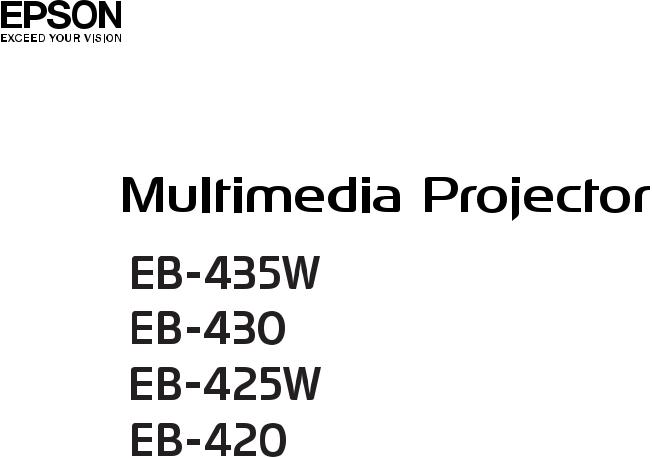
User’s Guide

Notations Used in This Guide
•Safety indications
The documentation and the projector use graphical symbols to show how to use the projector safely.
The indications and their meaning are as follows. Make sure you understand them properly before reading the guide.
|
Warning |
This symbol indicates information that, if ignored, could possibly result in personal injury or even death due to incorrect handling. |
|
|
|
|
Caution |
This symbol indicates information that, if ignored, could possibly result in personal injury or physical damage due to incorrect handling. |
|
|
|
• General information indications |
|
|
|
|
|
|
Attention |
Indicates procedures which may result in damage or injury if sufficient care is not taken. |
|
|
|
|
a |
Indicates additional information and points which may be useful to know regarding a topic. |
|
|
|
|
s |
Indicates a page where detailed information regarding a topic can be found. |
|
|
|
|
g |
Indicates that an explanation of the underlined word or words in front of this symbol appears in the glossary of terms. See the "Glossary" |
|
|
section of the "Appendices". |
|
|
s "Glossary" p.129 |
|
|
|
|
[Name] |
Indicates the name of the buttons on the remote control or the control panel. |
|
|
Example: [Esc] button |
|
|
|
|
Menu Name |
Indicates Configuration menu items. |
|
|
Example: |
|
|
Select Brightness from Image. |
|
|
Image - Brightness |
|
|
|

Contents |
|
3 |
|
|
|
Notations Used in This Guide . . . . . . . . . . . . . . . . . . . . . . . . 2
Introduction
Projector Features . . . . . . . . . . . . . . . . . . . . . . . . . . . . . . . . . . . . . . . . . . 7
Projection Functions . . . . . . . . . . . . . . . . . . . . . . . . . . . . . . . . . . . . . . . . . . . . 7 Enabling projection from a short distance . . . . . . . . . . . . . . . . . . . . . . . . . . . . 7 Easy writing on a whiteboard or blackboard using the pattern function . . . . . . . . 7 Connecting with a USB cable and projecting (USB Display) . . . . . . . . . . . . . . . . 7
Connecting to a network and projecting images from the computer's screen
. . . . . . . . . . . . . . . . . . . . . . . . . . . . . . . . . . . . . . . . . . . . . . . . . . . . . . . . . 7 Enhanced security functions . . . . . . . . . . . . . . . . . . . . . . . . . . . . . . . . . . . . . 7 Optional Functions . . . . . . . . . . . . . . . . . . . . . . . . . . . . . . . . . . . . . . . . . . . . . 7 Enlarge and project your files with the Document Camera . . . . . . . . . . . . . . . . . 7 Easy connection to a computer with Quick Wireless . . . . . . . . . . . . . . . . . . . . . 7
Part Names and Functions . . . . . . . . . . . . . . . . . . . . . . . . . . . . . . . . . . . 8
Front/Top . . . . . . . . . . . . . . . . . . . . . . . . . . . . . . . . . . . . . . . . . . . . . . . . . . . 8
Rear . . . . . . . . . . . . . . . . . . . . . . . . . . . . . . . . . . . . . . . . . . . . . . . . . . . . . . . 9
Base . . . . . . . . . . . . . . . . . . . . . . . . . . . . . . . . . . . . . . . . . . . . . . . . . . . . . . 10
Control Panel . . . . . . . . . . . . . . . . . . . . . . . . . . . . . . . . . . . . . . . . . . . . . . . . 11
Remote Control . . . . . . . . . . . . . . . . . . . . . . . . . . . . . . . . . . . . . . . . . . . . . . . 12
Replacing the remote control batteries . . . . . . . . . . . . . . . . . . . . . . . . . . . . . 15
Remote control operating range . . . . . . . . . . . . . . . . . . . . . . . . . . . . . . . . . 15
Preparing the Projector
Installing the Projector . . . . . . . . . . . . . . . . . . . . . . . . . . . . . . . . . . . . . 17
Installation Methods . . . . . . . . . . . . . . . . . . . . . . . . . . . . . . . . . . . . . . . . . . . 17
Connecting Equipment . . . . . . . . . . . . . . . . . . . . . . . . . . . . . . . . . . . . . 18
Connecting a Computer . . . . . . . . . . . . . . . . . . . . . . . . . . . . . . . . . . . . . . . . . 18 Connecting Image Sources . . . . . . . . . . . . . . . . . . . . . . . . . . . . . . . . . . . . . . . 19 Connecting USB Devices . . . . . . . . . . . . . . . . . . . . . . . . . . . . . . . . . . . . . . . . . 22 Connecting a microphone . . . . . . . . . . . . . . . . . . . . . . . . . . . . . . . . . . . . . . . 23
Connecting External Equipment . . . . . . . . . . . . . . . . . . . . . . . . . . . . . . . . . . . 24 Connecting a LAN Cable . . . . . . . . . . . . . . . . . . . . . . . . . . . . . . . . . . . . . . . . . 24 Installing the Optional Wireless LAN Unit . . . . . . . . . . . . . . . . . . . . . . . . . . . . . 26
Basic Usage
Projecting images . . . . . . . . . . . . . . . . . . . . . . . . . . . . . . . . . . . . . . . . . 28
From Installation to Projection . . . . . . . . . . . . . . . . . . . . . . . . . . . . . . . . . . . . . 28
Automatically Detect Input Signals and Change the Projected Image (Source Search)
. . . . . . . . . . . . . . . . . . . . . . . . . . . . . . . . . . . . . . . . . . . . . . . . . . . . . . . . . . 29 Switching to the Target Image Using the Remote Control . . . . . . . . . . . . . . . . . . 30 Projecting with USB Display . . . . . . . . . . . . . . . . . . . . . . . . . . . . . . . . . . . . . . 30 System requirements . . . . . . . . . . . . . . . . . . . . . . . . . . . . . . . . . . . . . . . . . 30 Connecting for the first time . . . . . . . . . . . . . . . . . . . . . . . . . . . . . . . . . . . . 31 Uninstalling . . . . . . . . . . . . . . . . . . . . . . . . . . . . . . . . . . . . . . . . . . . . . . . 32
Adjusting Projected Images . . . . . . . . . . . . . . . . . . . . . . . . . . . . . . . . 34
Correcting Keystone Distortion . . . . . . . . . . . . . . . . . . . . . . . . . . . . . . . . . . . . 34 H/V-Keystone . . . . . . . . . . . . . . . . . . . . . . . . . . . . . . . . . . . . . . . . . . . . . . 34 Quick Corner . . . . . . . . . . . . . . . . . . . . . . . . . . . . . . . . . . . . . . . . . . . . . . . 35 Adjusting the Image Size . . . . . . . . . . . . . . . . . . . . . . . . . . . . . . . . . . . . . . . . 37 Adjusting the Image Position . . . . . . . . . . . . . . . . . . . . . . . . . . . . . . . . . . . . . 37 Adjusting the Horizontal Tilt . . . . . . . . . . . . . . . . . . . . . . . . . . . . . . . . . . . . . . 37 Correcting the Focus . . . . . . . . . . . . . . . . . . . . . . . . . . . . . . . . . . . . . . . . . . . 38 Adjusting the Volume . . . . . . . . . . . . . . . . . . . . . . . . . . . . . . . . . . . . . . . . . . 38 Selecting the Projection Quality (Selecting Color Mode) . . . . . . . . . . . . . . . . . . . 38 Setting Auto Iris . . . . . . . . . . . . . . . . . . . . . . . . . . . . . . . . . . . . . . . . . . . . . . 39 Changing the Aspect Ratio of the Projected Image . . . . . . . . . . . . . . . . . . . . . . . 40 Changing methods . . . . . . . . . . . . . . . . . . . . . . . . . . . . . . . . . . . . . . . . . . 40 Changing the aspect mode (EB-435W/EB-425W only) . . . . . . . . . . . . . . . . . . . 40 Changing the aspect mode (EB-430/EB-420 only) . . . . . . . . . . . . . . . . . . . . . . 41
Useful Functions
Projection Functions . . . . . . . . . . . . . . . . . . . . . . . . . . . . . . . . . . . . . . . 44
Hiding the Image and Sound Temporarily (A/V Mute) . . . . . . . . . . . . . . . . . . . . . 44

Contents |
|
4 |
|
|
|
Freezing the Image (Freeze) . . . . . . . . . . . . . . . . . . . . . . . . . . . . . . . . . . . . . . 44 Pointer Function (Pointer) . . . . . . . . . . . . . . . . . . . . . . . . . . . . . . . . . . . . . . . . 45 Enlarging Part of the Image (E-Zoom) . . . . . . . . . . . . . . . . . . . . . . . . . . . . . . . . 46 Using the Remote Control to Operate the Mouse Pointer (Wireless Mouse) . . . . . . 47 Saving a User's Logo . . . . . . . . . . . . . . . . . . . . . . . . . . . . . . . . . . . . . . . . . . . 48 Saving User Pattern . . . . . . . . . . . . . . . . . . . . . . . . . . . . . . . . . . . . . . . . . . . . 50
Security Functions . . . . . . . . . . . . . . . . . . . . . . . . . . . . . . . . . . . . . . . . . 52
Managing Users (Password Protect) . . . . . . . . . . . . . . . . . . . . . . . . . . . . . . . . . 52 Kinds of Password Protect . . . . . . . . . . . . . . . . . . . . . . . . . . . . . . . . . . . . . . 52 Setting Password Protect . . . . . . . . . . . . . . . . . . . . . . . . . . . . . . . . . . . . . . 52 Entering the Password . . . . . . . . . . . . . . . . . . . . . . . . . . . . . . . . . . . . . . . . 53 Restricting Operation (Control Panel Lock) . . . . . . . . . . . . . . . . . . . . . . . . . . . . 54 Anti-Theft Lock . . . . . . . . . . . . . . . . . . . . . . . . . . . . . . . . . . . . . . . . . . . . . . . 55 Installing the wire lock . . . . . . . . . . . . . . . . . . . . . . . . . . . . . . . . . . . . . . . . 55
Configuration Menu
Using the Configuration Menu . . . . . . . . . . . . . . . . . . . . . . . . . . . . . . 57
List of Functions . . . . . . . . . . . . . . . . . . . . . . . . . . . . . . . . . . . . . . . . . . . 58
Configuration Menu Table . . . . . . . . . . . . . . . . . . . . . . . . . . . . . . . . . . . . . . . 58 Network menu . . . . . . . . . . . . . . . . . . . . . . . . . . . . . . . . . . . . . . . . . . . . . 59 Image Menu . . . . . . . . . . . . . . . . . . . . . . . . . . . . . . . . . . . . . . . . . . . . . . . . . 60 Signal Menu . . . . . . . . . . . . . . . . . . . . . . . . . . . . . . . . . . . . . . . . . . . . . . . . . 61 Settings Menu . . . . . . . . . . . . . . . . . . . . . . . . . . . . . . . . . . . . . . . . . . . . . . . . 63 Extended Menu . . . . . . . . . . . . . . . . . . . . . . . . . . . . . . . . . . . . . . . . . . . . . . . 64 Network Menu . . . . . . . . . . . . . . . . . . . . . . . . . . . . . . . . . . . . . . . . . . . . . . . 66 Notes on operating the Network menu . . . . . . . . . . . . . . . . . . . . . . . . . . . . . 67 Soft keyboard operations . . . . . . . . . . . . . . . . . . . . . . . . . . . . . . . . . . . . . . 67 Basic menu . . . . . . . . . . . . . . . . . . . . . . . . . . . . . . . . . . . . . . . . . . . . . . . . 68 Wireless LAN menu . . . . . . . . . . . . . . . . . . . . . . . . . . . . . . . . . . . . . . . . . . 68 Security menu . . . . . . . . . . . . . . . . . . . . . . . . . . . . . . . . . . . . . . . . . . . . . . 70 Wired LAN menu . . . . . . . . . . . . . . . . . . . . . . . . . . . . . . . . . . . . . . . . . . . . 71 Mail menu . . . . . . . . . . . . . . . . . . . . . . . . . . . . . . . . . . . . . . . . . . . . . . . . 72 Others menu . . . . . . . . . . . . . . . . . . . . . . . . . . . . . . . . . . . . . . . . . . . . . . 73 Reset menu . . . . . . . . . . . . . . . . . . . . . . . . . . . . . . . . . . . . . . . . . . . . . . . 74
Info Menu (Display Only) . . . . . . . . . . . . . . . . . . . . . . . . . . . . . . . . . . . . . . . . 74
Reset Menu . . . . . . . . . . . . . . . . . . . . . . . . . . . . . . . . . . . . . . . . . . . . . . . . . 75
Troubleshooting
Using the Help . . . . . . . . . . . . . . . . . . . . . . . . . . . . . . . . . . . . . . . . . . . . . 78
Problem Solving . . . . . . . . . . . . . . . . . . . . . . . . . . . . . . . . . . . . . . . . . . . 79
Reading the Indicators . . . . . . . . . . . . . . . . . . . . . . . . . . . . . . . . . . . . . . . . . . 79 When the Indicators Provide No Help . . . . . . . . . . . . . . . . . . . . . . . . . . . . . . . . 82 Problems Relating to Images . . . . . . . . . . . . . . . . . . . . . . . . . . . . . . . . . . . . . . 83 No images appear . . . . . . . . . . . . . . . . . . . . . . . . . . . . . . . . . . . . . . . . . . . 83
Moving images are not displayed (only the moving image portion turns black)
. . . . . . . . . . . . . . . . . . . . . . . . . . . . . . . . . . . . . . . . . . . . . . . . . . . . . . . . 84 Projection stops automatically . . . . . . . . . . . . . . . . . . . . . . . . . . . . . . . . . . . 84 The message "Not supported" is displayed. . . . . . . . . . . . . . . . . . . . . . . . . . . 84 The message "No Signal" is displayed. . . . . . . . . . . . . . . . . . . . . . . . . . . . . . . 84 Images are fuzzy, out of focus, or distorted . . . . . . . . . . . . . . . . . . . . . . . . . . 85 Interference or distortion appear in images . . . . . . . . . . . . . . . . . . . . . . . . . . 85 The image is truncated (large) or small, or the aspect is not suitable . . . . . . . . . 86 Image colors are not right . . . . . . . . . . . . . . . . . . . . . . . . . . . . . . . . . . . . . . 87 Images appear dark . . . . . . . . . . . . . . . . . . . . . . . . . . . . . . . . . . . . . . . . . . 87
Problems when Projection Starts . . . . . . . . . . . . . . . . . . . . . . . . . . . . . . . . . . . 88 The projector does not turn on . . . . . . . . . . . . . . . . . . . . . . . . . . . . . . . . . . 88 Other Problems . . . . . . . . . . . . . . . . . . . . . . . . . . . . . . . . . . . . . . . . . . . . . . . 89 No sound can be heard or the sound is faint . . . . . . . . . . . . . . . . . . . . . . . . . 89 No sound can be heard from the microphone . . . . . . . . . . . . . . . . . . . . . . . . 89 The remote control does not work . . . . . . . . . . . . . . . . . . . . . . . . . . . . . . . . 90 I want to change the language for messages and menus . . . . . . . . . . . . . . . . . 90 Mail is not received even if an error occurs with the projector . . . . . . . . . . . . . 90
About Event ID . . . . . . . . . . . . . . . . . . . . . . . . . . . . . . . . . . . . . . . . . . . . 92

Contents |
|
5 |
|
|
|
Maintenance
Cleaning . . . . . . . . . . . . . . . . . . . . . . . . . . . . . . . . . . . . . . . . . . . . . . . . . . 94
Cleaning the Projector's Surface . . . . . . . . . . . . . . . . . . . . . . . . . . . . . . . . . . . 94 Cleaning the Lens . . . . . . . . . . . . . . . . . . . . . . . . . . . . . . . . . . . . . . . . . . . . . 94 Cleaning the Air Filter . . . . . . . . . . . . . . . . . . . . . . . . . . . . . . . . . . . . . . . . . . . 94
Replacing Consumables . . . . . . . . . . . . . . . . . . . . . . . . . . . . . . . . . . . . 96
Replacing the Lamp . . . . . . . . . . . . . . . . . . . . . . . . . . . . . . . . . . . . . . . . . . . . 96 Lamp replacement period . . . . . . . . . . . . . . . . . . . . . . . . . . . . . . . . . . . . . . 96 How to replace the lamp . . . . . . . . . . . . . . . . . . . . . . . . . . . . . . . . . . . . . . 96 Resetting the lamp hours . . . . . . . . . . . . . . . . . . . . . . . . . . . . . . . . . . . . . . 99 Replacing the Air Filter . . . . . . . . . . . . . . . . . . . . . . . . . . . . . . . . . . . . . . . . . . 99 Air filter replacement period . . . . . . . . . . . . . . . . . . . . . . . . . . . . . . . . . . . . 99 How to replace the air filter . . . . . . . . . . . . . . . . . . . . . . . . . . . . . . . . . . . . . 99
Appendix
Slideshow . . . . . . . . . . . . . . . . . . . . . . . . . . . . . . . . . . . . . . . . . . . . . . . . 103
Projecting Without a Computer (Slideshow) . . . . . . . . . . . . . . . . . . . . . . . . . . 103 Specifications for files that can be projected using Slideshow . . . . . . . . . . . . . 103 Slideshow examples . . . . . . . . . . . . . . . . . . . . . . . . . . . . . . . . . . . . . . . . . 103 Slideshow operating methods . . . . . . . . . . . . . . . . . . . . . . . . . . . . . . . . . . 103 Projecting the selected image . . . . . . . . . . . . . . . . . . . . . . . . . . . . . . . . . . 105 Projecting image files in a folder in sequence (Slideshow) . . . . . . . . . . . . . . . 106 Image file display settings and Slideshow operation settings . . . . . . . . . . . . . 107
Monitoring and Controlling . . . . . . . . . . . . . . . . . . . . . . . . . . . . . . . 108
About EasyMP Monitor . . . . . . . . . . . . . . . . . . . . . . . . . . . . . . . . . . . . . . . . . 108 Changing Settings Using a Web Browser (Web Control) . . . . . . . . . . . . . . . . . . . 108 Projector setup . . . . . . . . . . . . . . . . . . . . . . . . . . . . . . . . . . . . . . . . . . . . 108 Displaying the Web Control screen . . . . . . . . . . . . . . . . . . . . . . . . . . . . . . . 109 Displaying the Web Remote screen . . . . . . . . . . . . . . . . . . . . . . . . . . . . . . 109 Using the Mail Notification Function to Report Problems . . . . . . . . . . . . . . . . . . 111 Reading Error Notification Mail . . . . . . . . . . . . . . . . . . . . . . . . . . . . . . . . . 111 Management Using SNMP . . . . . . . . . . . . . . . . . . . . . . . . . . . . . . . . . . . . . . 111
ESC/VP21 Commands . . . . . . . . . . . . . . . . . . . . . . . . . . . . . . . . . . . . . . . . . . 112
Command list . . . . . . . . . . . . . . . . . . . . . . . . . . . . . . . . . . . . . . . . . . . . . 112
Cable layouts . . . . . . . . . . . . . . . . . . . . . . . . . . . . . . . . . . . . . . . . . . . . . 112
About PJLink . . . . . . . . . . . . . . . . . . . . . . . . . . . . . . . . . . . . . . . . . . . . . . . . 113
About Crestron RoomView® . . . . . . . . . . . . . . . . . . . . . . . . . . . . . . . . . . . . . 114
Operating a projector from your computer . . . . . . . . . . . . . . . . . . . . . . . . . 114
Optional Accessories and Consumables . . . . . . . . . . . . . . . . . . . . 118
Optional Accessories . . . . . . . . . . . . . . . . . . . . . . . . . . . . . . . . . . . . . . . . . . 118
Consumables . . . . . . . . . . . . . . . . . . . . . . . . . . . . . . . . . . . . . . . . . . . . . . . 118
Screen Size and Projection Distance . . . . . . . . . . . . . . . . . . . . . . . . 119
Projection Distance (For EB-430/EB-420) . . . . . . . . . . . . . . . . . . . . . . . . . . . . . 119 Projection Distance (For EB-435W/EB-425W) . . . . . . . . . . . . . . . . . . . . . . . . . . 120
Supported Monitor Displays . . . . . . . . . . . . . . . . . . . . . . . . . . . . . . . 122
Supported Resolutions . . . . . . . . . . . . . . . . . . . . . . . . . . . . . . . . . . . . . . . . . 122 Computer signals (analog RGB) . . . . . . . . . . . . . . . . . . . . . . . . . . . . . . . . . 122 Component Video . . . . . . . . . . . . . . . . . . . . . . . . . . . . . . . . . . . . . . . . . . 122 Composite video . . . . . . . . . . . . . . . . . . . . . . . . . . . . . . . . . . . . . . . . . . . 122 Input signal from the HDMI port . . . . . . . . . . . . . . . . . . . . . . . . . . . . . . . . 122
Specifications . . . . . . . . . . . . . . . . . . . . . . . . . . . . . . . . . . . . . . . . . . . . 124
Projector General Specifications . . . . . . . . . . . . . . . . . . . . . . . . . . . . . . . . . . . |
124 |
Appearance . . . . . . . . . . . . . . . . . . . . . . . . . . . . . . . . . . . . . . . . . . . . . . 128
Glossary . . . . . . . . . . . . . . . . . . . . . . . . . . . . . . . . . . . . . . . . . . . . . . . . . 129
General Notes . . . . . . . . . . . . . . . . . . . . . . . . . . . . . . . . . . . . . . . . . . . . 131
About Notations . . . . . . . . . . . . . . . . . . . . . . . . . . . . . . . . . . . . . . . . . . . . . 131
General Notice: . . . . . . . . . . . . . . . . . . . . . . . . . . . . . . . . . . . . . . . . . . . . . . 131
Index . . . . . . . . . . . . . . . . . . . . . . . . . . . . . . . . . . . . . . . . . . . . . . . . . . . . 132

Introduction
This chapter explains the projector's features and the part names.

Projector Features |
|
7 |
|
|
|
Projection Functions
Enabling projection from a short distance
You can project large images from a short distance without having to move the projector away from the screen.
s "Screen Size and Projection Distance" p.119
Easy writing on a whiteboard or blackboard using the pattern function
You can project ruled lines and grid patterns. This is useful when drawing diagrams on a whiteboard or blackboard.
s Settings - Pattern p.63
Connecting with a USB cable and projecting (USB Display)
By simply connecting a commercially available USB cable, you can project images from a computer's screen without a computer cable.
s "Projecting with USB Display" p.30
Connecting to a network and projecting images from the computer's screen
You can connect the projector to a computer on a network and project the computer's screen using the supplied EasyMP Network Projection (application software).
sEasyMP Network Projection Operation Guide
Enhanced security functions
•Password Protect to restrict and manage users
By setting a password you can restrict who can use the projector. s "Managing Users (Password Protect)" p.52
•Control Panel Lock restricts button operation on the control panel
You can use this to prevent people changing projector settings without permission at events, in schools, and so on.
s "Restricting Operation (Control Panel Lock)" p.54
•Equipped with various anti-theft devices
The projector is equipped with the following types of anti-theft security devices.
•Security slot
•Security cable installation point
s "Anti-Theft Lock" p.55
Optional Functions
Enlarge and project your files with the Document Camera
You can project paper documents and objects using the optional Document Camera. Image focus is automatically adjusted using the auto focus function. You can also enlarge images using digital zoom.
s "Optional Accessories" p.118
Easy connection to a computer with Quick Wireless
By simply connecting the optional Quick Wireless Connection USB Key to a computer, you can project the computer's screen. (Windows computers only)
s "Optional Accessories" p.118
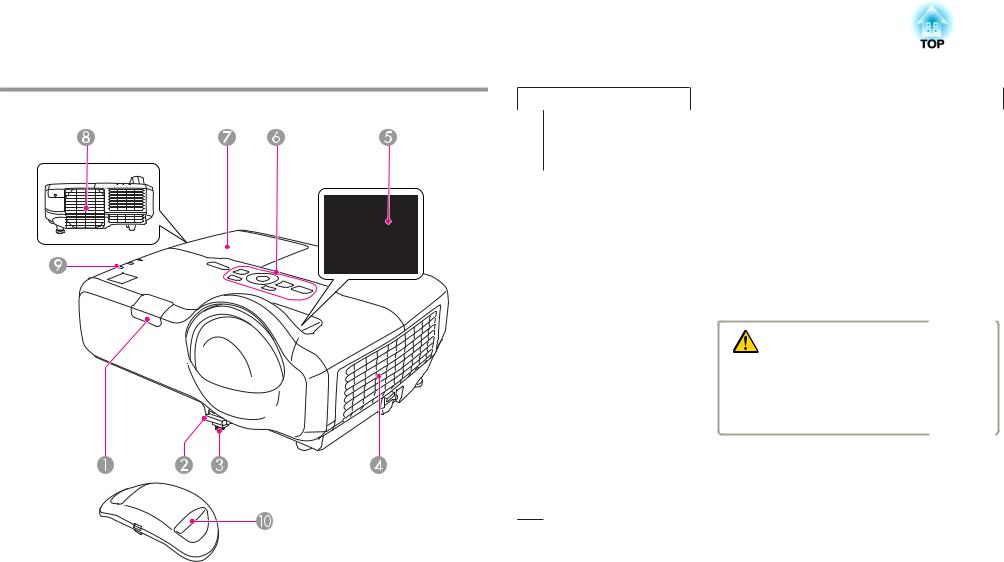
Part Names and Functions |
|
8 |
|
|
|
Front/Top
|
Name |
Function |
A |
Remote receiver |
Receives signals from the remote control. |
|
|
|
B |
Foot adjust lever |
Press the foot lever to extend and retract the front foot. |
|
|
s "Adjusting the Image Position" p.37 |
|
|
|
C |
Front adjustable foot |
When setup on a surface such as a desk, extend the foot to |
|
|
adjust the position of the image. |
|
|
s "Adjusting the Image Position" p.37 |
|
|
|
Name |
Function |
D Air intake vent |
Takes in air to cool the projector internally. |
(air filter) |
s "Cleaning the Air Filter" p.94 |
|
s "Replacing the Air Filter" p.99 |
|
|
E Focus ring |
Adjusts the image focus. |
|
s "Correcting the Focus" p.38 |
|
|
F Control panel |
Operates the projector. |
|
s "Control Panel" p.11 |
|
|
G Lamp cover |
Open when replacing the projector's lamp. |
|
s "Replacing the Lamp" p.96 |
|
|
H Air exhaust vent |
Exhaust vent for air used to cool the projector internally. |
|
|
Caution |
|
|
|
While projecting, do not put your face or hands |
|
|
|
near the air exhaust vent, and do not place objects |
|
|
|
that may become warped or damaged by heat near |
|
|
|
the vent. |
|
|
|
|
|
|
|
||
I Indicators |
Indicates the projector's status. |
||
|
s "Reading the Indicators" p.79 |
||
|
|
||
J Lens cover |
Attach the cover when not using the projector to prevent |
||
|
the lens from getting dirty or being damaged. |
||
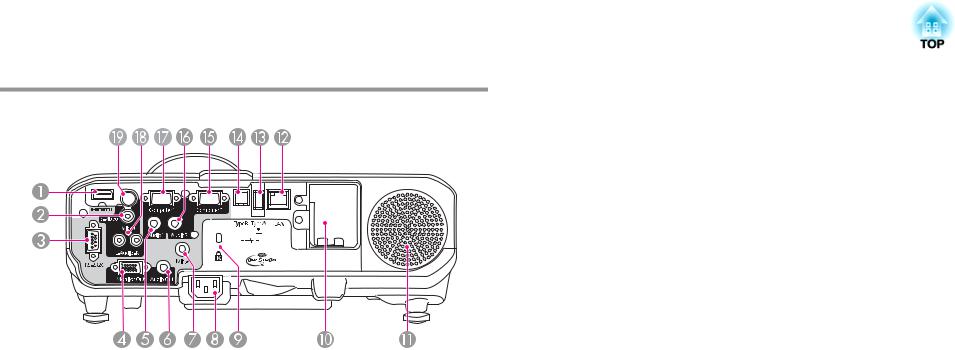
Part Names and Functions |
|
9 |
|
|
|
Rear
|
Name |
|
|
Function |
A |
HDMI port |
Inputs video signals from HDMI compatible video |
||
|
|
equipment and computers. This projector is compatible |
||
|
|
with HDCPg. |
||
|
|
|
|
|
|
|
s "Connecting Equipment" p.18 |
||
|
|
|
||
B |
Video port |
Inputs composite video signals from video sources. |
||
|
|
|
||
C |
RS-232C port |
When controlling the projector from a computer, connect |
||
|
|
it to the computer with an RS-232C cable. This port is for |
||
|
|
control use and should not normally be used. |
||
|
|
s "ESC/VP21 Commands" p.112 |
||
|
|
|
||
D |
Monitor Out port |
Outputs analog RGB signals input from the Computer1 |
||
|
|
port to an external monitor. You cannot output signals |
||
|
|
input from other ports or component video signals. |
||
|
|
|
||
E |
Audio1 port |
Inputs audio from equipment connected to the |
||
|
|
Computer1 port. |
||
|
|
|
||
F |
Audio Out port |
Outputs audio from the currently projected image or the |
||
|
|
Mic port to an external speaker. |
||
|
|
|
|
|
|
Name |
Function |
G |
Mic port |
Inputs audio from the microphone. |
|
|
s "Connecting a microphone" p.23 |
|
|
|
H |
Power inlet |
Connects the power cable to the projector. |
|
|
s "From Installation to Projection" p.28 |
|
|
|
I |
Security slot |
The security slot is compatible with the Microsaver |
|
|
Security System manufactured by Kensington. |
|
|
s "Anti-Theft Lock" p.55 |
|
|
|
J |
Wireless LAN unit |
Install the optional Wireless LAN unit here. Remove the |
|
installation section |
stopper when installing. |
|
|
s "Installing the Optional Wireless LAN Unit" p.26 |
|
|
|
K |
Speaker |
Outputs audio. |
|
|
|
L |
LAN port |
Connects a LAN cable to connect to a network. |
|
|
|
M |
USB(TypeA) port |
• Connects a USB memory device or a digital camera, and |
|
|
projects images as a Slideshow. |
|
|
s "Projecting Without a Computer (Slideshow)" |
|
|
p.103 |
|
|
• Connects the optional Document Camera. |
|
|
|
N |
USB(TypeB) port |
• Connects the projector to a computer via a |
|
|
commercially available USB cable, and projects the |
|
|
images on the computer. |
|
|
s "Projecting with USB Display" p.30 |
|
|
• Connects the projector to a computer via the |
|
|
commercially available USB cable to use the Wireless |
|
|
Mouse function. |
|
|
s "Using the Remote Control to Operate the |
|
|
Mouse Pointer (Wireless Mouse)" p.47 |
|
|
|
O |
Computer2 port |
Inputs image signals from a computer and component |
|
|
video signals from other video sources. |
|
|
|
P |
Audio2 port |
Inputs audio from equipment connected to the |
|
|
Computer2 port. |
|
|
|
Q |
Computer1 port |
Inputs image signals from a computer and component |
|
|
video signals from other video sources. |
|
|
|

Part Names and Functions |
|
10 |
|
|
|
|
Name |
Function |
R |
Audio-L/R port |
Inputs audio from equipment connected to the S-Video |
|
|
port or the Video port. |
|
|
|
S |
S-Video port |
For S-video signals from video sources. |
|
|
|
Base
Name |
Function |
ACeiling mount fixing Attach the optional Ceiling Mount here when suspending points (three points) the projector from a ceiling.
|
s "Installing the Projector" p.17 |
|
s "Optional Accessories" p.118 |
|
|
B Wall mount plate |
Attach the optional wall mount plate here when |
fixing points (five |
suspending the projector from a wall. |
points) |
s "Optional Accessories" p.118 |
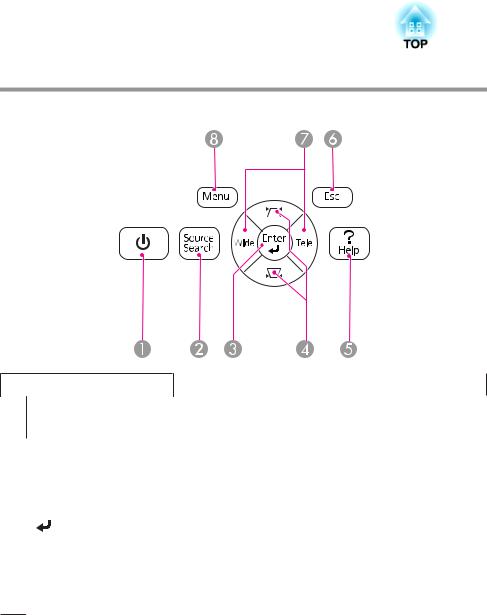
Part Names and Functions |
|
11 |
|
|
|
|
Name |
Function |
C |
Rear feet |
When setup on a surface such as a desk, turn to extend and |
|
|
retract to adjust the horizontal tilt. |
|
|
s "Adjusting the Horizontal Tilt" p.37 |
|
|
|
D |
Security cable |
Pass a commercially available wire lock through here and |
|
installation point |
lock it in place. |
|
|
s "Installing the wire lock" p.55 |
|
|
|
E |
Front adjustable foot |
When setup on a surface such as a desk, extend the foot to |
|
|
adjust the position of the image. |
|
|
s "Adjusting the Image Position" p.37 |
|
|
|
Control Panel
Name |
Function |
A [t] button |
Turns the projector power on or off. |
|
s "From Installation to Projection" p.28 |
|
|
B [Source Search] |
Switches to the image from the input port where video |
button |
signals are being input. |
|
s "Automatically Detect Input Signals and Change the |
|
Projected Image (Source Search)" p.29 |
|
|
C [ ] button |
• When the Configuration menu or the Help screen is |
|
displayed, it accepts and enters the current selection and |
|
moves to the next level. |
•If pressed while projecting analog RGB signals from Computer1 port or Computer2 port, you can automatically optimize Tracking, Sync., and Position.

Part Names and Functions |
|
12 |
|
|
|
|
Name |
Function |
|
|
|
|
|
|
|
|
|
|
|
|
|
|
|
|
|
|
|
|
Remote Control |
||||||||||||||||||||
D |
[w][v] button |
• Displays the Keystone screen allowing you to correct |
|||||||||||||||||||
|
|
|
|
|
|
|
|
|
|
|
|
|
|
|
|
|
|
||||
|
|
keystone distortion in vertical and horizontal |
|
|
|
|
|
|
|
|
|
|
|
|
|
|
|
|
|
|
|
|
|
directions. |
|
|
|
|
|
|
|
|
|
|
|
|
|
|
|
|
|
|
|
|
|
s "H/V-Keystone" p.34 |
|
|
|
|
|
|
|
|
|
|
|
|
|
|
|
|
|
|
|
|
|
• If pressed when the Configuration menu or the Help |
|
|
|
|
|
|
|
|
|
|
|
|
|
|
|
|
|
|
|
|
|
screen is displayed, these buttons select menu items and |
|
|
|
|
|
|
|
|
|
|
|
|
|
|
|
|
|
|
|
|
|
setting values. |
|
|
|
|
|
|
|
|
|
|
|
|
|
|
|
|
|
|
|
|
|
s "Using the Configuration Menu" p.57 |
|
|
|
|
|
|
|
|
|
|
|
|
|
|
|
|
|
|
|
|
|
s "Using the Help" p.78 |
|
|
|
|
|
|
|
|
|
|
|
|
|
|
|
|
|
|
|
|
|
|
|
|
|
|
|
|
|
|
|
|
|
|
|
|
|
|
|
||
|
|
|
|
|
|
|
|
|
|
|
|
|
|
|
|
|
|
|
|
|
|
E |
[Help] button |
Displays and closes the help screen which shows you how |
|
|
|
|
|
|
|
|
|
|
|
|
|
|
|
|
|
|
|
|
|
to deal with problems if they occur. |
|
|
|
|
|
|
|
|
|
|
|
|
|
|
|
|
|
|
|
|
|
s "Using the Help" p.78 |
|
|
|
|
|
|
|
|
|
|
|
|
|
|
|
|
|
|
|
|
|
|
|
|
|
|
|
|
|
|
|
|
|
|
|
|
|
|
|
|
|
F |
[Esc] button |
• Stops the current function. |
|
|
|
|
|
|
|
|
|
|
|
|
|
|
|
|
|
|
|
|
|
|
|
|
|
|
|
|
|
|
|
|
|
|
|
|
|
||||
|
|
|
|
|
|
|
|
|
|
|
|
|
|
|
|
|
|
||||
|
|
• If pressed when the Configuration menu is displayed, it |
|
|
|
|
|
|
|
|
|
|
|
|
|
|
|
|
|
|
|
|
|
|
|
|
|
|
|
|
|
|
|
|
|
|
|
|
|
|
|
||
|
|
moves to the previous menu level. |
|
|
|
|
|
|
|
|
|
|
|
|
|
|
|
|
|
|
|
|
|
s "Using the Configuration Menu" p.57 |
|
|
|
|
|
|
|
|
|
|
|
|
|
|
|
|
|
|
|
|
|
|
|
|
|
|
|
|
|
|
|
|
|
|
|
|
|
|
|
|
|
G |
[Tele]/[Wide] buttons |
• Adjusts the size of the projection screen. Press the [Tele] |
|
|
|
|
|
|
|
|
|
|
|
|
|
|
|
|
|
|
|
|
|
|
|
|
|
|
|
|
|
|
|
|
|
|
|
|
|
||||
|
|
button to reduce the size of the projection screen and |
|
|
|
|
|
|
|
|
|
|
|
|
|
|
|
|
|
|
|
|
|
press the [Wide] button to increase the size of the |
|
|
|
|
|
|
|
|
|
|
|
|
|
|
|
|
|
|
|
|
|
projection screen. |
|
|
|
|
|
|
|
|
|
|
|
|
|
|
|
|
|
|
|
|
|
• Corrects keystone distortion in the horizontal direction |
|
|
|
|
|
|
|
|
|
|
|
|
|
|
|
|
|
|
|
|
|
|
|
|
|
|
|
|
|
|
|
|
|
|
|
|
|
|
|
||
|
|
when the Keystone screen is displayed. |
|
|
|
|
|
|
|
|
|
|
|
|
|
|
|
|
|
|
|
|
|
s "H/V-Keystone" p.34 |
|
|
|
|
|
|
|
|
|
|
|
|
|
|
|
|
|
|
|
|
|
• If pressed when the Configuration menu or the Help |
|
|
|
|
|
|
|
|
|
|
|
|
|
|
|
|
|
|
|
|
|
|
|
|
|
|
|
|
|
|
|
|
|
|
|
|
|
|
|
||
|
|
|
|
|
|
|
|
|
|
|
|
|
|
|
|
|
|
|
|
||
|
|
screen is displayed, these buttons select menu items and |
|
|
|
|
|
|
|
|
|
|
|
|
|
|
|
|
|
|
|
|
|
setting values. |
|
|
|
|
|
|
|
|
|
|
|
|
|
|
|
|
|
|
|
|
|
s "Using the Configuration Menu" p.57 |
|
|
|
|
|
|
|
|
|
|
|
|
|
|
|
|
|
|
|
|
|
|
|
|
|
|
|
|
|
|
|
|
|
|
|
|
|
|
|
||
|
|
s "Using the Help" p.78 |
|
|
|
|
|
|
|
|
|
|
|
|
|
|
|
|
|
|
|
|
|
|
|
|
|
|
|
|
|
|
|
|
|
|
|
|
|
|
|
||
|
|
|
|
|
|
|
|
|
|
|
|
|
|
|
|
|
|
|
|
|
|
H |
[Menu] button |
Displays and closes the Configuration menu. |
|
|
|
|
|
|
|
|
|
|
|
|
|
|
|
|
|
|
|
|
|
s "Using the Configuration Menu" p.57 |
|
|
|
|
|
|
|
|
|
|
|
|
|
|
|
|
|
|
|
|
|
|
|
|
|
|
|
|
|
|
|
|
|
|
|
|
|
|
|
|
|
|
|
|
|
|
|
|
|
|
|
|
|
|
|
|
|
|
|
|
|
|
|
|
|
|
|
|
|
|
|
|
|
|
|
|
|
|
|
|
|
|
|
|
|

Part Names and Functions |
|
13 |
|
|
|
|
Name |
Function |
A |
[t] button |
Turns the projector power on or off. |
|
|
s "From Installation to Projection" p.28 |
|
|
|
B |
[Computer] button |
Each time you press the button, the input changes between |
|
|
images from the Computer1 port and the Computer2 |
|
|
port. |
|
|
|
C |
[Video] button |
Each time the button is pressed, the image cycles through |
|
|
the S-Video, Video, and HDMI ports. |
|
|
|
D |
Numeric buttons |
• Enter the Password. |
|
|
s "Setting Password Protect" p.52 |
|
|
• Use this button to enter numbers in Network settings |
|
|
from the Configuration menu. |
|
|
|
E |
[Auto] button |
If pressed while projecting analog RGB signals from |
|
|
Computer1 port or Computer2 port, you can |
|
|
automatically optimize Tracking, Sync., and Position. |
|
|
|
F |
[Aspect] button |
Each time the button is pressed, the aspect mode changes. |
|
|
s "Changing the Aspect Ratio of the Projected Image" |
|
|
p.40 |
|
|
|
G |
[Num] button |
Hold down this button and press the numeric buttons to |
|
|
enter passwords and numbers. |
|
|
s "Setting Password Protect" p.52 |
|
|
|
H |
[Menu] button |
Displays and closes the Configuration menu. |
|
|
s "Using the Configuration Menu" p.57 |
|
|
|
Name |
Function |
I [ ][ ][ ][ ] |
• When the Configuration menu or Help screen is |
button |
displayed, pressing these buttons selects menu items |
and setting values. |
|
|
s "Using the Configuration Menu" p.57 |
•When projecting a Slideshow, pressing these buttons displays the previous/next image, rotates the image, and so on.
s "Slideshow operating methods" p.103
•During Wireless Mouse function, the mouse pointer moves in the direction of the button that was pushed. s "Using the Remote Control to Operate the Mouse Pointer (Wireless Mouse)" p.47
J [User] button |
Select any frequently used item from the seven available |
|
Configuration menu items, and assign it to this button. By |
|
pressing the [User] button, the assigned menu item |
|
selection/adjustment screen is displayed, allowing you to |
|
make one-touch settings/adjustments. |
|
s "Settings Menu" p.63 |
|
Power Consumption is assigned as the default setting. |
|
|
K [Page] buttons |
Changes pages in files such as PowerPoint files when using |
[[][]] |
the following projection methods. |
|
• When using the Wireless Mouse function |
|
s "Using the Remote Control to Operate the |
|
Mouse Pointer (Wireless Mouse)" p.47 |
|
• When using USB Display |
|
s "Projecting with USB Display" p.30 |
|
• When connecting to a network |
|
When projecting images using Slideshow, pressing these |
|
buttons displays the previous/next image file. |
|
|
L [A/V Mute] button |
Turns the video and audio on or off. |
|
s "Hiding the Image and Sound Temporarily (A/V |
|
Mute)" p.44 |

Part Names and Functions |
|
14 |
|
|
|
|
Name |
Function |
M |
[E-Zoom] buttons |
Enlarges or reduces the image without changing the |
|
[z][x] |
projection size. |
|
|
s "Enlarging Part of the Image (E-Zoom)" p.46 |
|
|
|
N |
Strap hole |
Allows you to attach a commercially available strap to the |
|
|
remote control. |
|
|
|
O |
[Help] button |
Displays and closes the help screen which shows you how |
|
|
to deal with problems if they occur. |
|
|
s "Using the Help" p.78 |
|
|
|
P |
[Freeze] button |
Pauses or resumes image playback. |
|
|
s "Freezing the Image (Freeze)" p.44 |
|
|
|
Q |
[Volume] buttons |
[a] Decreases the volume. |
|
[a][b] |
[b] Increases the volume. |
|
|
s "Adjusting the Volume" p.38 |
|
|
|
R |
[Pointer] button |
Displays the on-screen pointer. |
|
|
s "Pointer Function (Pointer)" p.45 |
|
|
|
S |
[ ] button |
• When the Configuration menu or the Help screen is |
|
|
displayed, it accepts and enters the current selection and |
|
|
moves to the next level. |
|
|
s "Using the Configuration Menu" p.57 |
|
|
• Acts as a mouse's left button when using the Wireless |
|
|
Mouse function. |
|
|
s "Using the Remote Control to Operate the |
|
|
Mouse Pointer (Wireless Mouse)" p.47 |
|
|
|
T |
[Esc] button |
• Stops the current function. |
|
|
• If pressed when the Configuration menu is displayed, it |
|
|
moves to the previous level. |
|
|
s "Using the Configuration Menu" p.57 |
|
|
• Acts as a mouse's right button when using the Wireless |
|
|
Mouse function. |
|
|
s "Using the Remote Control to Operate the |
|
|
Mouse Pointer (Wireless Mouse)" p.47 |
|
|
|
|
Name |
Function |
U |
[Color Mode] button |
Each time the button is pressed, the color mode changes. |
|
|
s "Selecting the Projection Quality (Selecting Color |
|
|
Mode)" p.38 |
|
|
|
V |
[LAN] button |
Changes to the images projected with EasyMP Network |
|
|
Projection. When projecting using the optional Quick |
|
|
Wireless Connection USB Key, this button switches to |
|
|
that image. |
|
|
|
W |
[USB] button |
Each time the button is pressed, it cycles through the |
|
|
following images: |
|
|
• USB Display |
|
|
• Images from the device connected to the USB(TypeA) |
|
|
port |
|
|
|
X |
[Source Search] |
Switches to the image from the input port where video |
|
button |
signals are being input. |
|
|
s "Automatically Detect Input Signals and Change the |
|
|
Projected Image (Source Search)" p.29 |
|
|
|
Y |
Remote control light- |
Outputs remote control signals. |
|
emitting area |
|
|
|
|
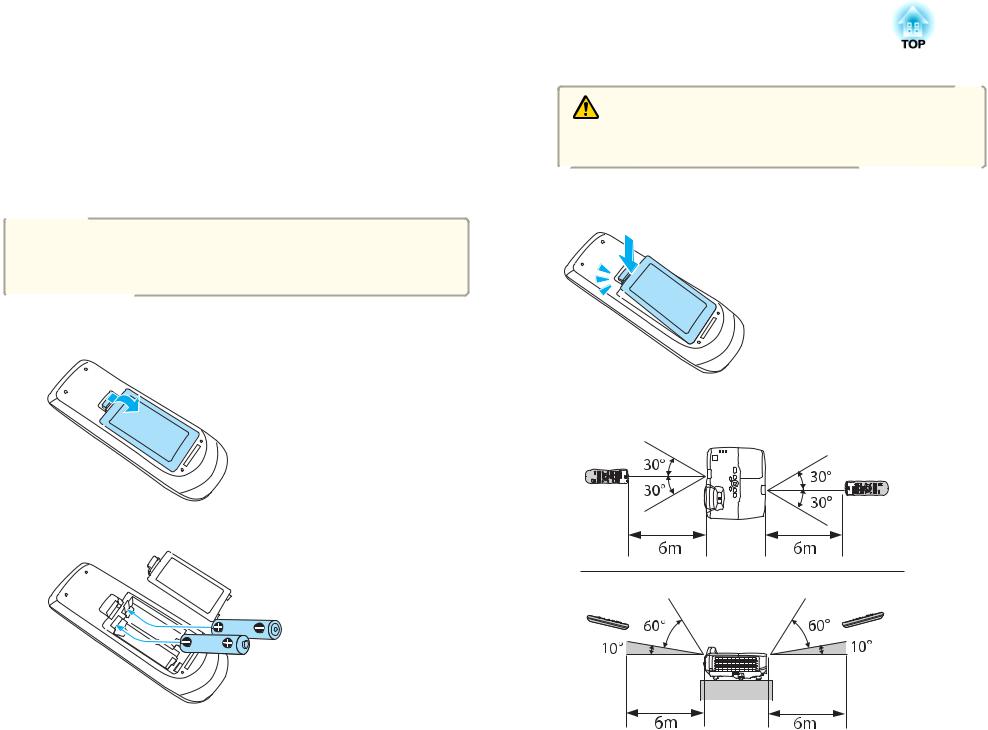
Part Names and Functions |
|
15 |
|
|
|
Replacing the remote control batteries
If the remote control becomes unresponsive or inoperable after it has been used for some time, the batteries may have reached the end of their service life. When this happens, replace them with new batteries. Obtain two AA size manganese or alkaline batteries. You cannot use other batteries except for the AA size manganese or alkaline.
Attention
Make sure you read the following manual before handling the batteries.
s Safety Instructions
a Remove the battery cover.
While pushing the battery cover catch, lift the cover up.
Caution
Check the positions of the (+) and (-) marks inside the battery holder to ensure the batteries are inserted the correct way.
c Reattach the battery cover.
Press the battery cover until it clicks into place.
Remote control operating range
b Replace the old batteries with new batteries.

Preparing the Projector
This chapter explains how to install the projector and connect projection sources.
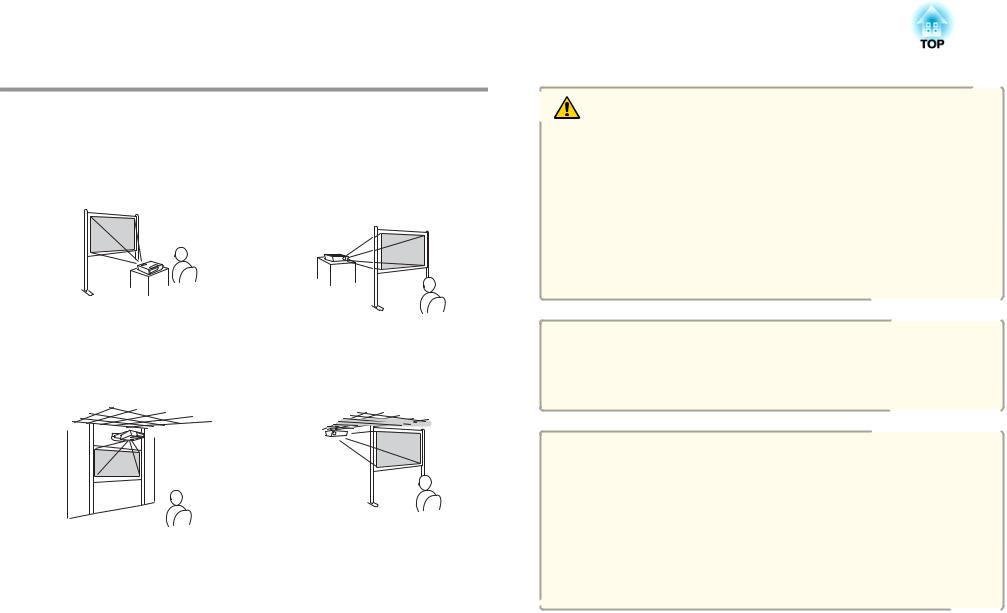
Installing the Projector |
|
17 |
|
|
|
Installation Methods
The projector supports the following four different projection methods. Install the projector according to the conditions of the installation location.
• Project images from in front of |
• Project images from behind a |
the screen. (Front projection) |
translucent screen. (Rear projec |
|
tion) |
•Suspend the projector from a wall or ceiling and project im ages from in front of a screen. (Front/Ceiling projection)
•Suspend the projector from the ceiling and project images from behind a translucent screen.
(Rear/Ceiling projection)
Warning
•A special method of installation is required when suspending the projector from a wall or ceiling. If it is not installed correctly, it could fall causing an accident and injury.
•If you use adhesives on the wall mount plate fixing points or the ceiling mount fixing points to prevent the screws from loosening, or if you use things such as lubricants or oils on the projector, the projector case may crack causing it to fall from its mount. This could cause serious injury to anyone under the mount and could damage the projector.
When installing or adjusting the mount, do not use adhesives to prevent the screws from loosening and do not use lubricant or oil and so on.
Attention
•Do not use the projector on its side. This may cause malfunctions to occur.
•Do not cover the projector's air intake vent or air exhaust vent. If either of the vents are covered, the internal temperature could rise and cause a fire.
a• When installing the projector on a wall or on the ceiling, make sure you use the correct tools for the installation method.
s "Optional Accessories" p.118
•You can change the setting as follows by pressing down the [A/V Mute] button on the remote control for about five seconds.
FrontWFront/Ceiling RearWRear/Ceiling
•Set Rear or Rear/Ceiling from the configuration menu. s Extended - Projection p.64

Connecting Equipment |
|
18 |
|
|
|
The port name, location, and connector orientation differ depending on the source being connected.
Connecting a Computer
To project images from a computer, connect the computer using one of the following methods.
A B When using the supplied computer cable
Connect the computer's display output port to the projector's Computer1 or Computer2 port.
You can output audio from the projector's speaker by connecting the computer's audio output port to the projector's Audio1 or Audio2 port using a commercially available audio cable.
CWhen using a commercially available USB cable
Connect the computer's USB port to the projector's USB(TypeB) port. You can send the audio with the projected image.
DWhen using a commercially available HDMI cable
Connect the computer's HDMI port to the projector's HDMI port. You can send the audio with the projected image.
aYou can switch the audio input by using Audio Input. s Extended - Operation - Audio Input p.64
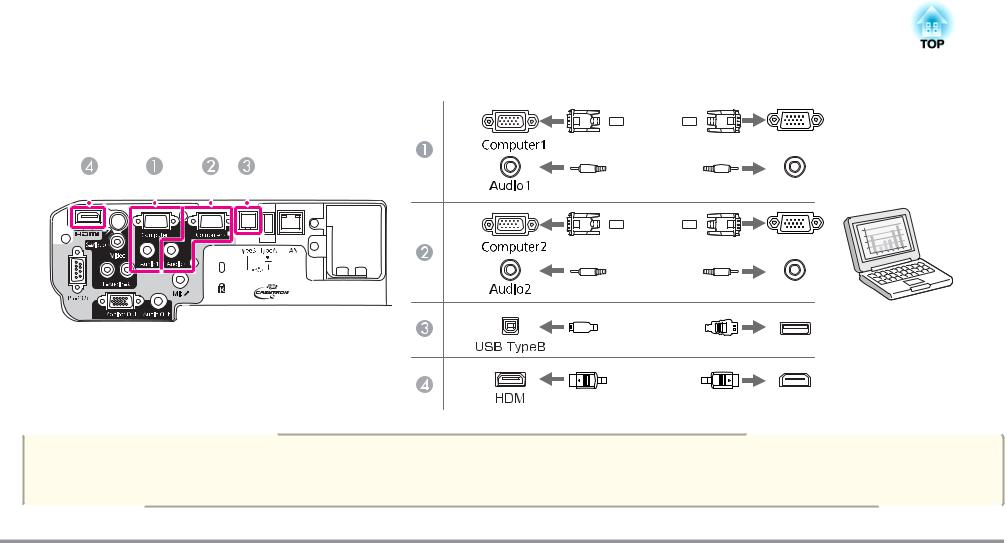
Connecting Equipment |
|
|
19 |
||||||||||||||||||||||||||||||||
|
|
|
|
|
|
|
|
|
|
|
|
|
|
|
|
|
|
|
|
|
|
|
|
|
|
|
|
|
|
|
|
|
|
|
|
|
|
|
|
|
|
|
|
|
|
|
|
|
|
|
|
|
|
|
|
|
|
|
|
|
|
|
|
|
|
|
|
|
|
|
|
|
|
|
|
|
|
|
|
|
|
|
|
|
|
|
|
|
|
|
|
|
|
|
|
|
|
|
|
|
|
|
|
|
|
|
|
|
|
|
|
|
|
|
|
|
|
|
|
|
|
|
|
|
|
|
|
|
|
|
|
|
|
|
|
|
|
|
|
|
|
|
|
|
|
|
|
|
|
|
|
|
|
|
|
|
|
|
|
|
|
|
|
|
|
|
|
|
|
|
|
|
|
|
|
|
|
|
|
|
|
|
|
|
|
|
|
|
|
|
|
|
|
|
|
|
|
|
|
|
|
|
|
|
|
|
|
|
|
|
|
|
|
|
|
|
|
|
|
|
|
|
|
|
|
|
|
|
|
|
|
|
|
|
|
|
|
|
|
|
|
|
|
|
|
|
|
|
|
|
|
|
|
|
|
|
|
|
|
|
|
|
|
|
|
|
|
|
|
|
|
|
|
|
|
|
|
|
|
|
|
|
|
|
|
|
|
|
|
|
|
|
|
|
|
|
|
|
|
|
|
|
|
|
|
|
|
|
|
|
|
|
|
|
|
|
|
|
|
|
|
|
|
|
|
|
|
|
|
|
|
|
|
|
|
|
|
|
|
|
|
|
|
|
|
|
|
|
|
|
|
|
|
|
|
|
|
|
|
|
|
|
|
|
|
|
|
|
|
|
|
|
|
|
|
|
|
|
|
|
|
|
|
|
|
|
|
|
|
|
|
|
|
|
|
|
|
|
|
|
|
|
|
|
|
|
|
|
|
|
|
|
|
|
|
|
|
|
|
|
|
|
|
|
|
|
|
|
|
|
|
|
|
|
|
|
|
|
|
|
|
|
|
|
|
|
|
|
|
|
|
|
|
|
|
|
|
|
|
|
|
|
|
|
|
|
|
aYou can use the commercially available USB cable to connect the projector to a computer to project images from the computer.This function is called USB Display.
s "Projecting with USB Display" p.30
Connecting Image Sources
To project images from DVD players or VHS video and so on, connect to the projector using one of the following methods.
AWhen using a commercially available video cable
Connect the video output port on the image source to the projector's Video port using a commercially available video cable.
You can output audio from the projector's speaker by connecting the audio output port on the image source to the projector's Audio-L/R port using a commercially available audio cable.
BWhen using a commercially available S-video cable

Connecting Equipment |
|
20 |
|
|
|
Connect the video output port on the image source to the projector's S-Video port using a commercially available video cable.
You can output audio from the projector's speaker by connecting the audio output port on the image source to the projector's Audio-L/R port using a commercially available audio cable.
C D When using the optional component video cable s "Optional Accessories and Consumables" p.118
Connect the component output port on the image source to the projector's Computer1 or Computer2 port.
You can output audio from the projector's speaker by connecting the image source's audio output port to the projector's Audio1 or Audio2 port using a commercially available audio cable.
EWhen using a commercially available HDMI cable
Connect the HDMI port on the image source to the projector's HDMI port using a commercially available HDMI cable. You can send the audio with the projected image.
aYou can switch the audio input by using Audio Input. s Extended - Operation - Audio Input p.64
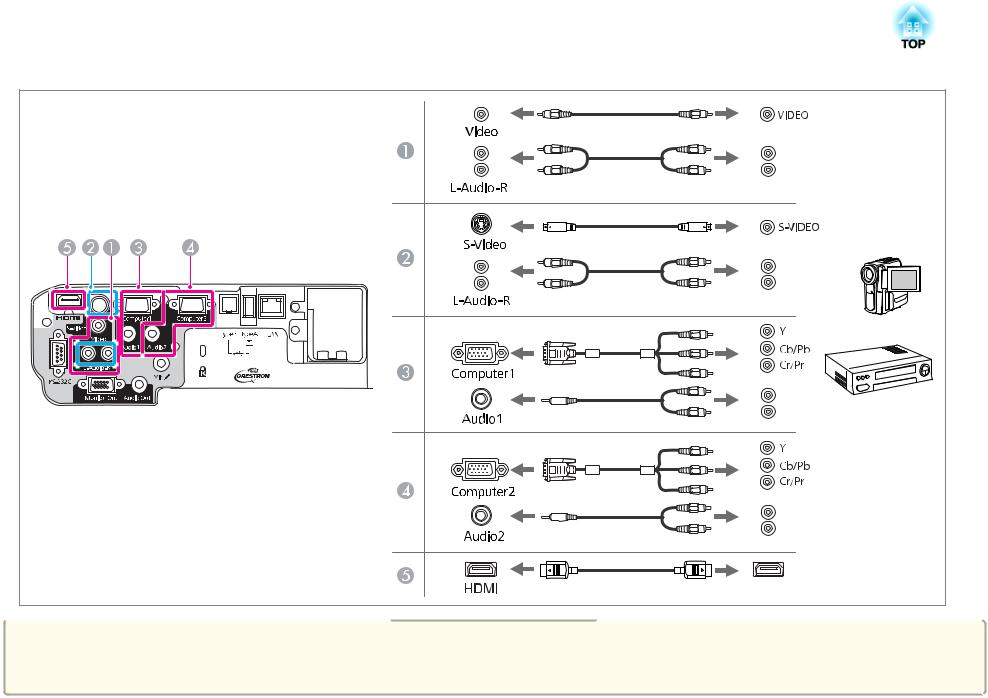
Connecting Equipment |
|
21 |
|
|
|
Attention |
• If |
the |
input source is on when you connect it to the |
projector, it could cause a malfunction. |
• If |
the |
orientation or shape of the plug differs, do not |
try to force it in. The device could be damaged or could malfunction. |
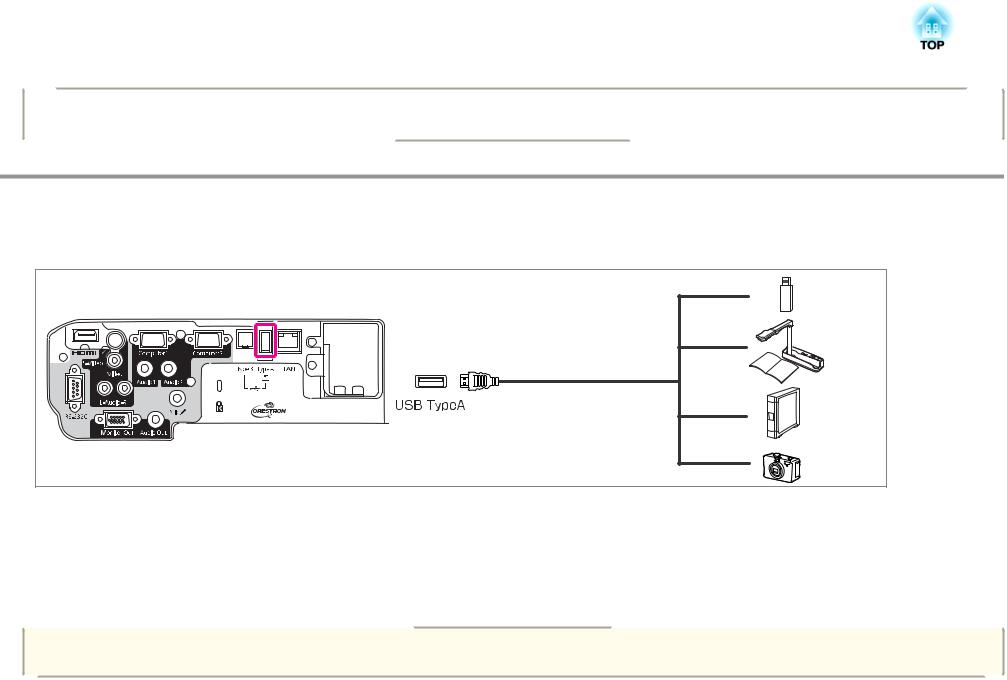
Connecting Equipment |
|
22 |
|
|
|
a |
• |
If the source you want to connect to |
has an unusually shaped port, use the cable supplied with the device or an optional cable to connect to the projector. |
|
• |
When using a commercially available |
2RCA(L/R)/stereo mini-pin audio cable, make sure it is labeled "No resistance". |
|
|
|
|
Connecting USB Devices
You can connect devices such as USB memory, the optional Document Camera, and USB compatible hard disks and digital cameras. Using the USB cable supplied with the USB device, connect the USB device to the USB(TypeA) port on the projector.
When the USB device is connected, you can project image files on the USB memory or digital camera using Slideshow. s "Slideshow" p.103
If the Document Camera is connected while projecting images from another input port, press the [USB] button on the remote control, or the [Source Search] button on the control panel, to switch to images from the Document Camera.
s "Automatically Detect Input Signals and Change the Projected Image (Source Search)" p.29
aWhile projecting images from a USB device, if you want to connect an audio output device, connect it to the Audio2 port.
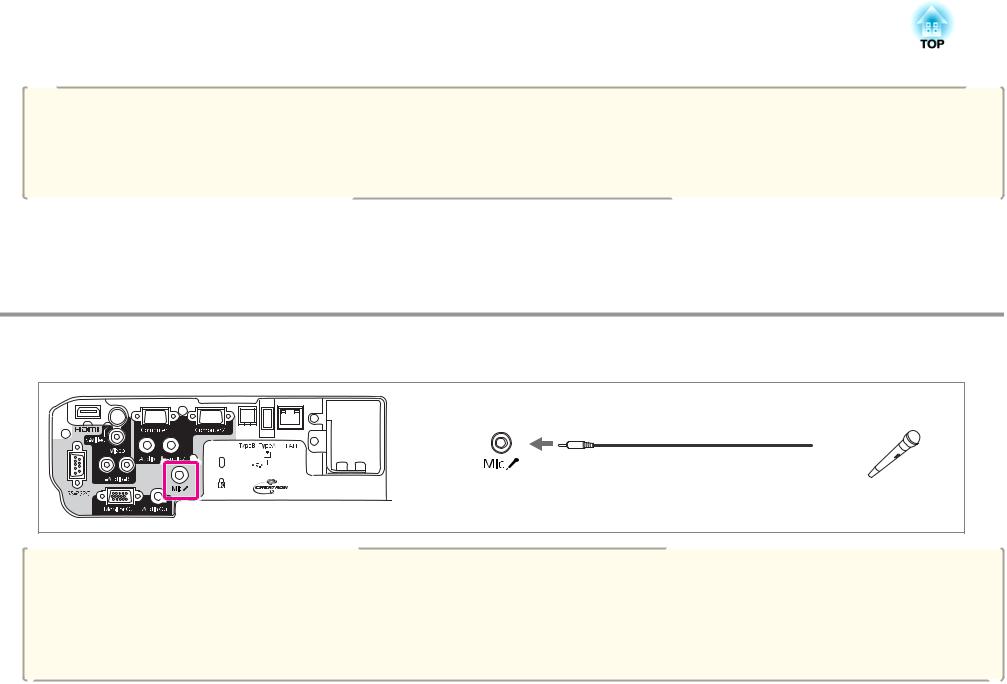
Connecting Equipment |
|
23 |
|
|
|
Attention
• If you |
use a USB hub, operation may not be performed correctly. Devices such as digital cameras and USB |
devices |
should be connected to the projector directly. |
||||
• When |
connecting and using |
a USB-compatible hard disk, make |
sure you connect the AC adaptor supplied with the |
hard disk. |
|||
• Connect a digital camera or |
hard disk to the projector using a |
USB |
cable supplied |
with or specified for use |
with the device. |
||
• Use a |
USB cable less than 3 |
m in length. If the cable exceeds |
3 m, |
Slideshow may |
not function correctly. |
|
|
Removing USB devices
After finishing projecting, remove USB devices from the projector. For devices such as digital cameras or hard disks, turn off the device and then remove it from the projector.
Connecting a microphone
You can output microphone audio from the projector's speaker by connecting a commercially available dynamic microphone.
a• Plug-in-power is not supported.
• Adjust Mic Input Level if the microphone audio is difficult to hear, or if it is too loud resulting in a crackling sound. s Settings - Mic Input Level p.63
•Make the following settings to output audio from a microphone when the projector is turned off. Set Standby Mode to Communication On. s Extended - Standby Mode p.64
Set Standby Microphone to On. s Extended - Standby Microphone p.64
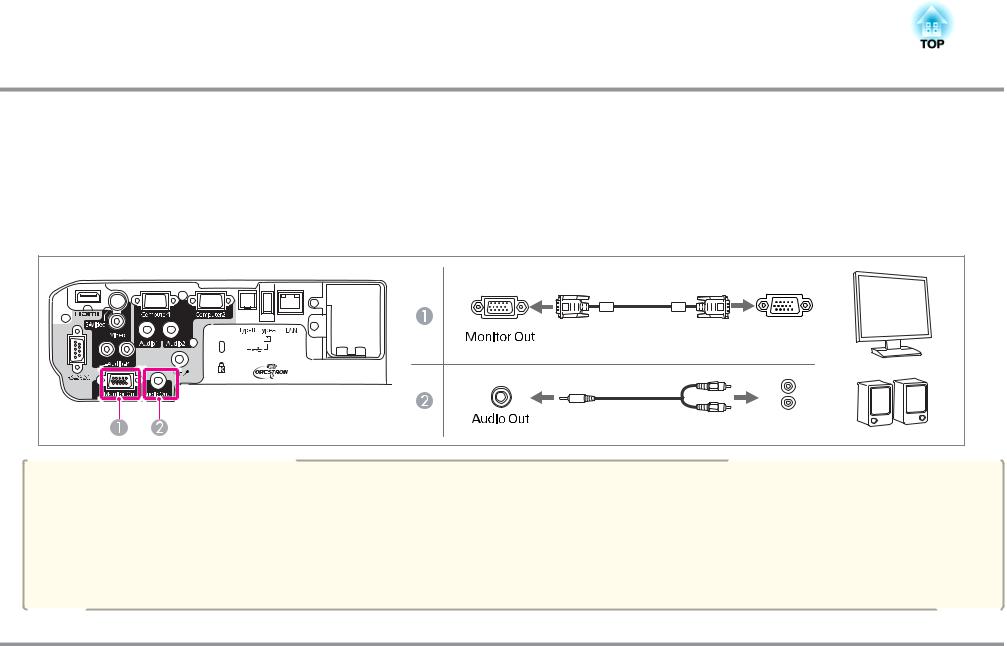
Connecting Equipment |
|
24 |
|
|
|
Connecting External Equipment
You can output images and audio by connecting an external monitor or speaker.
AWhen outputting images to an external monitor
Connect the external monitor to the projector's Monitor Out port using the cable supplied with the external monitor.
BWhen outputting audio to an external speaker
Connect the external speaker to the projector's Audio Out port using a commercially available audio cable.
a |
• If you set Standby Mode to Communication On, you can output images to |
an external |
monitor even |
if |
the projector is in standby mode. |
|
s Extended - Standby Mode p.64 |
|
|
|
|
|
• Only analog RGB signals from the Computer1 port can be output to an external monitor. You cannot output signals input from other ports or component video |
||||
|
signals. |
|
|
|
|
|
• Setting gauges for functions such as Keystone, Configuration menu, or Help |
screens are |
not output to |
the |
external monitor. |
•When the audio cable jack is inserted into the Audio Out port, audio stops being output from the projector's built-in speakers and switches to external output.
Connecting a LAN Cable
Connect a LAN port on network hubs or other equipment to the projector's LAN port with a commercially available 100BASE-TX or 10BASE-T LAN cable.

Connecting Equipment |
|
|
25 |
|||||||||||||||||||
|
|
|
|
|
|
|
|
|
|
|
|
|
|
|
|
|
|
|
|
|
|
|
|
|
|
|
|
|
|
|
|
|
|
|
|
|
|
|
|
|
|
|
|
|
|
|
|
|
|
|
|
|
|
|
|
|
|
|
|
|
|
|
|
|
|
|
|
|
|
|
|
|
|
|
|
|
|
|
|
|
|
|
|
|
|
|
|
|
|
|
|
aTo prevent malfunctions, use a category 5 shielded LAN cable.
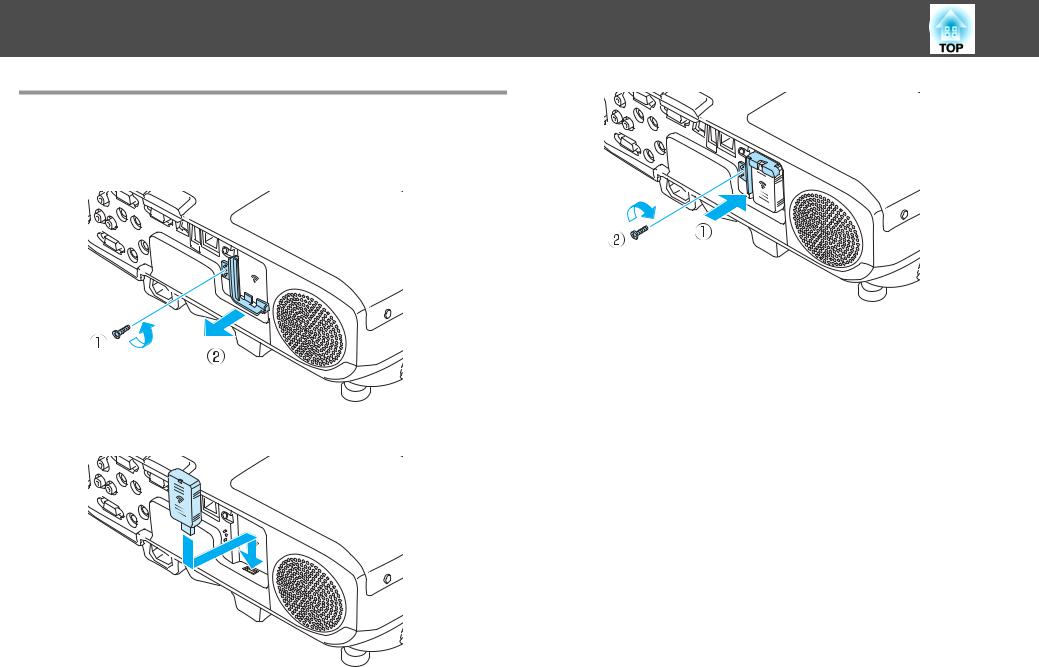
Connecting Equipment |
26 |
Installing the Optional Wireless LAN Unit
a Remove the stopper fixing screw, and then remove the wireless LAN unit's stopper.
b Install the Wireless LAN unit.
c To avoid losing the wireless LAN unit, secure the stopper using the stopper fixing screw.

Basic Usage
This chapter explains how to project and adjust images.
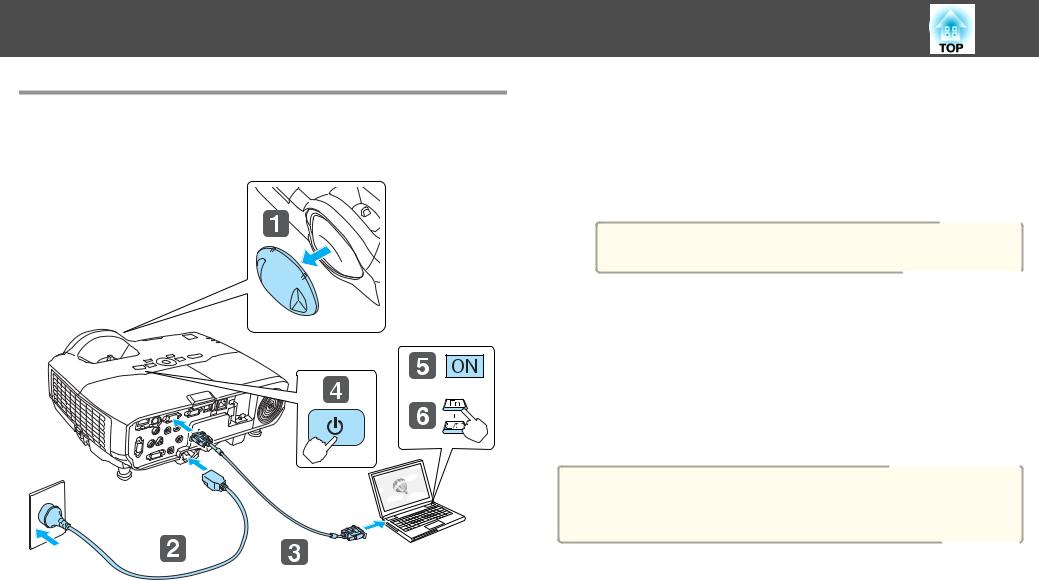
Projecting images
From Installation to Projection
This section explains the procedure for connecting the projector to a computer with the computer cable and projecting images.
a Remove the lens cover.
b Connect the projector to an electrical outlet with the power cable. |
|
c |
Connect the projector to the computer with the computer cable. |
d |
Turn on the projector. |
|
|
28
e Turn on the computer.
f Change the computer's screen output.
When using a laptop computer, you need to change the screen output from the computer.
Hold down the Fn key (function key), and press the b key.
aThe method for changing differs depending on the computer being used. See the documentation supplied with the computer.
If the image is not projected, you can change the projected image using one of the following methods.
•Press the [Source Search] button on the control panel or the remote control.
s "Automatically Detect Input Signals and Change the Projected Image (Source Search)" p.29
•Press the button for the target port on the remote control.
s "Switching to the Target Image Using the Remote Control" p.30
aAfter projecting the image, adjust the image if necessary. s "Correcting Keystone Distortion" p.34
s "Correcting the Focus" p.38
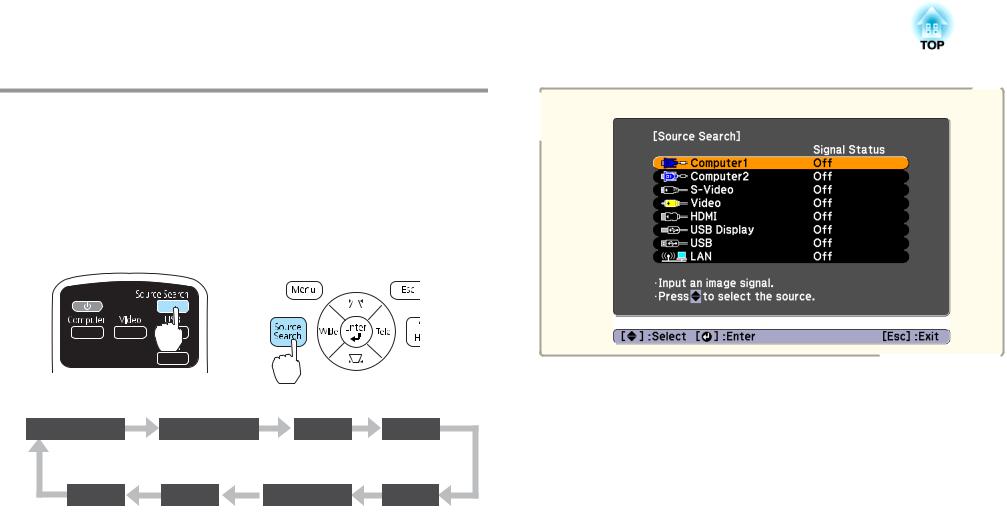
Projecting images |
|
29 |
|
|
|
Automatically Detect Input Signals and Change |
a |
|
The following screen is displayed while no image signals are input. |
the Projected Image (Source Search) |
|
Press the [Source Search] button to project images from the port currently receiving an image.
Because only images from ports receiving an image are projected, you can quickly project the image you want.
Using Remote Control |
Using the Control Panel |
Computer1 |
Computer2 |
S-Video |
Video |
LAN |
USB |
USB Display |
HDMI |
When two or more image sources are connected, press the [Source Search] button until the target image is projected.
When your video equipment is connected, start playback before beginning this operation.
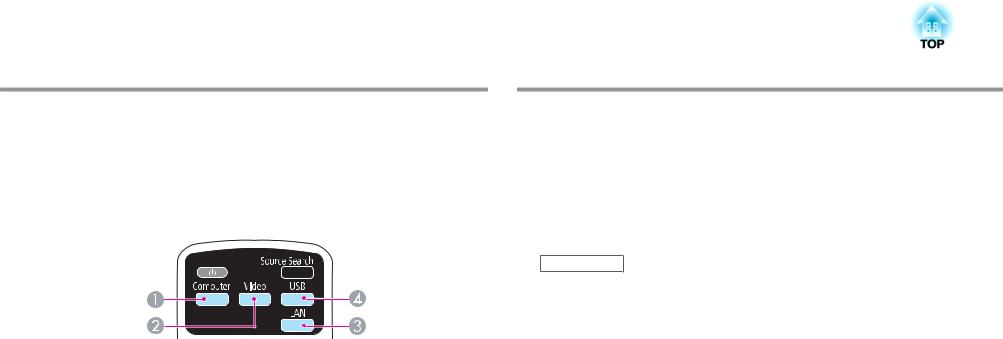
Projecting images |
|
30 |
|
|
|
Switching to the Target Image Using the Remote Control
You can change directly to the target image by pressing the following buttons on the remote control.
Remote control
AEach time the button is pressed, it cycles through the following images:
•Computer1 port
•Computer2 port
BEach time the button is pressed, it cycles through the following images:
•S-Video port
•Video port
•HDMI port
CChanges to the images projected with EasyMP Network Projection. When projecting using the optional Quick Wireless Connection USB Key, this button switches to that image.
DEach time the button is pressed, it cycles through the following images:
•USB Display
•Images from the device connected to the USB(TypeA) port
Projecting with USB Display
You can use the commercially available USB cable to connect the projector to a computer to project images from the computer.
You can send the computer's audio with the projected image.
System requirements
For Windows
OS |
|
Windows 2000*1 |
|
|
|
|
Windows XP*2 |
|
Professional 32 bit, Home Edition 32 |
|
|
|
|
bit, Tablet PC Edition 32 bit |
|
|
|
|
|
|
|
Windows Vista |
|
Ultimate 32 bit, Enterprise 32 bit, |
|
|
|
|
Business 32 bit, Home Premium 32 |
|
|
|
|
bit, Home Basic 32 bit |
|
|
|
|
|
|
|
Windows 7 |
|
Ultimate 32/64 bit, Enterprise 32/64 |
|
|
|
|
bit, Professional 32/64 bit, Home |
|
|
|
|
Premium 32/64 bit, Home Basic 32 |
|
|
|
|
bit, Starter 32 bit |
|
|
|
|
|
CPU |
|
Mobile Pentium III 1.2 GHz or faster |
||
|
|
Recommended: Pentium M 1.6 GHz or faster |
||
|
|
|
|
|
Amount of |
|
256 MB or more |
|
|
Memory |
|
Recommended: 512 MB or more |
||
|
|
|
|
|
Hard Disk |
|
20 MB or more |
|
|
Free Space |
|
|
|
|
|
|
|
||
Display |
|
Resolution of no less than 640x480 and no higher than |
||
|
|
1600x1200. |
|
|
|
|
Display color of |
16-bit color or greater |
|
|
|
|
|
|
*1 Service Pack 4 only |
|
|
||
*2 Except for |
Service Pack 1 |
|
|
|
